Okazaki Castle
-Hardship history of young Ieyasu Tokugawa-
Overview
Name: Okazaki castle (Okazaki-jo)
Alias: Ryuga-jo (Dragon castle)Place: Kosei-cho Okazaki city, Aichi
Location: 34.95634663762256, 137.1588403007719
Type: Hill castle
Built: Originally beginning of 16th century, expanded in 1590's
Remaining remnants: Stone walls, clay walls and moats
Title: 100 famous Japanese castles
Okazaki castle (岡崎城) is placed on a small hill beside the Tomoegawa river, a tributary of Yahagigawa river. Okazaki city, the city located on the center of Mikawa region (western Aichi prefecture), is a place where Tokaido way cross Yahagigawa river, and a connecting point of land and water transportation. This city is also a posting place of Tokaido way.
Okazaki castle was a main base of Tokugawa clan between 1530 to 1570, and the birth place of Ieyasu Tokugawa (1543-1616), the founder of Edo shogunate. At first Tokugawa clan was named as Matsudaira clan (renamed to Tokugawa in 1567).
The origin of Matsudaira clan is considered as a descendant of Serada clan located in Kozuke province (Gunma prefecture), a family of Yoshishige Nitta, a famous general of Nanboku-cho era (14th century). But precisely beginning of Matsudaira clan is unclear, and it is said that a wandering monk located in Matsudaira village in current Toyota city and married with a daughter of local lord, and started to expand his territory.
By the time of third head Chikauji, Matsudaira clan expanded its territory to Okazaki eria and located his sons various places around here. fourth leader Chikatada Matsudaira moved his location to Anjo castle (Anjo city) and stayed there until the time of sixth leader Nobutada Matsudaira.
Seventh leader Kiyoyasu Matsudaira (1511-1535) was a brilliant leader. He succeeded leader position only at 12 years old in 1523, then captured Okazaki castle from local lord in 1526. During next three years, he advanced to east Mikawa region, and forced local lords to follow him. By the end of 1529, Kiyoyasu once united Mikawa province only in 6 years.
But in 1530, when Kiyoyasu attacked Moriyama Castle at Owari province (western Aichi prefecture) held by Nobuhide Oda (1510-1551), father of Nobunaga Oda (1534-1582), he was assassinated by his retainer probably bribe by Nobuhide, and hardship of Matsudaira Klan had begun from this accident (It is said the Musamasa sword, a model of Murasame sword in Wizardry was used for assassination).
His son and eighth head Hirotada Matsudaira (1526-1549) could not succeed the position by obstacle of other relative, but supported by Yoshimoto Imagawa (1519-1560), a warlord of Suruga and Totomi country (both Shizuoka prefecture), and finally took the position and entered Okazaki castle around 1538. He also married with Odai-no kata, a daughter of Mizuno clan located in west Mikawa, and Ieyasu was born in 1543 in Okazaki castle.
But there was a severe conflict with Oda clan, and as Mizuno clan decided to support Oda clan, Hirotada had to divorce his wife. In addition to this, Anjo castle was deprived by Oda clan in 1540’s, and he had to send Ieyasu to Imagawa clan as a hostage to get more support. Finally Hirotada died at only 24 years old in 1549.
During next 10 year Matsudaira clan lacked their leader and subordinated to Imagawa clan. Imagawa general stayed at Okazaki castle, and retainers of Matsudaira had to cultivate to feed themselves in poverty.
Among Imagawa army escaped to their nation, Ieyasu in despair once decided to kill himself before the tomb of Matsudaica lan, but was admonished by the monk of Daijyuji temple he desisted it. After that Ieyasu continued his fight to terminate battles, under the slogan of "Onri Edo Gongu Jyodo" , it means leave the dirty world and seek for peaceful world.
Ieyasu first recovered Okazaki castle as a new leader of Matsudaira clan but continued to belong to Imagawa clan. But seeing inactivity of Ujizane Imagawa (1538-1615), the successor of Yoshimoto, Ieyasu became independent from Imagawa clan and made a treaty with Oda clan at Kiyosu castle in 1562, to protect backward of each other.
Once the security of backside was established, Ieyasu started to expel Imagawa army from eastern Mikawa country. Suffered from the rebel of Ikkoshu denomination, a denomination of Japanese Buddhism, occurred in 1563, but Ieyasu finally captured Yoshida castle by 1566 and Matsudaira clan could unite Mikawa country again.
After that, Ieyasu agreed with Shingen Takeda (1521-1573), a war lord of Kai province (Yamanashi prefecture), to attack Imagawa clan collaboratively and separate Imagawa territory. He occupied Totomi country (western part of Shizuoka prefecture) in 1569, newly built Hamamatsu castle and moved there from Okazaki castle. Now Ieyasu left his hard time and moved for further growth. Considering the hardships in his life, it is said Ieyasu mentioned that life is alike to ascend a slope with heavy burden.
After Ieyasu’s movement, Nobuyasu Tokugawa (1559-1579), eldest son of Ieyasu served as a commander of Okazaki castle. But in 1579 he was forced to suicide at Futamata castle under suspect of communication to Takeda clan. After that accident Kazumasa Ishikawa (1534-1609), an important retainer of Ieyasu, was placed on Okazaki, but due to the internal conflict on the diplomatic policy against central ruler Hideyoshi Toyotomi (1537-1598), in 1585, Kazumasa left Tokugawa clan and ran into Toyotomi clan.
In 1590 Tokugawa clan was transferred to Kanto region by Toyotomi government, and Yoshimasa Tanaka (1548-1609), an old retainer of Hideyoshi, was appointed as a commander. Yoshimasa transformed Okazaki castle into a modern one surrounded by stone walls.
After the battle of Sekigahara in 1600, Tanaka clan moved to Yanagawa castle (FUkuoka prefecture) and Okazaki castle returned to Tokugawa clan again. Honda clan which was a hereditary retainer of Ieyasu became the lord of Okazaki castle and built a three story main tower in 1617. Okazaki castle was thought important as a birthplace of the founder of Ieyasu, and high rank Tokugawa hereditary retainer were located on this castle.
Subsequent to Meiji revolution, all building were demolished and outer areas were lost by city development. But in 1959, main tower was reconstructed in old exterior, and recently several turrets were restored. Currently castle site became Okazaki park with many trees, and is covered by flowers and red leafs in spring and autumn.
20 minutes walk from Meitetsu Nagoya-Honsen line Higashi Okazaki station. 30 minutes drive from Tomei Expressway Okazaki interchange.
Hamamatsu Castle -Castle of promotion-
Sunpu Castle -Memorable place of first shogun
Edo Castle -Inner area built by talented general-
Futamata Castle -Ending place of Ieyasu's eldest son
KIyosu Castle -Place of important alliance and conferece-
Kurume Castle -Castle of lords steadily climbed up the ladder-
Type: Hill castle
Built: Originally beginning of 16th century, expanded in 1590's
Remaining remnants: Stone walls, clay walls and moats
Title: 100 famous Japanese castles
Brief History
Okazaki castle (岡崎城) is placed on a small hill beside the Tomoegawa river, a tributary of Yahagigawa river. Okazaki city, the city located on the center of Mikawa region (western Aichi prefecture), is a place where Tokaido way cross Yahagigawa river, and a connecting point of land and water transportation. This city is also a posting place of Tokaido way.
Origin of Tokugawa (Matsudaira) clan
Okazaki castle was a main base of Tokugawa clan between 1530 to 1570, and the birth place of Ieyasu Tokugawa (1543-1616), the founder of Edo shogunate. At first Tokugawa clan was named as Matsudaira clan (renamed to Tokugawa in 1567).
The origin of Matsudaira clan is considered as a descendant of Serada clan located in Kozuke province (Gunma prefecture), a family of Yoshishige Nitta, a famous general of Nanboku-cho era (14th century). But precisely beginning of Matsudaira clan is unclear, and it is said that a wandering monk located in Matsudaira village in current Toyota city and married with a daughter of local lord, and started to expand his territory.
By the time of third head Chikauji, Matsudaira clan expanded its territory to Okazaki eria and located his sons various places around here. fourth leader Chikatada Matsudaira moved his location to Anjo castle (Anjo city) and stayed there until the time of sixth leader Nobutada Matsudaira.
Expansion under Kiyoyasu and hardship after that
Seventh leader Kiyoyasu Matsudaira (1511-1535) was a brilliant leader. He succeeded leader position only at 12 years old in 1523, then captured Okazaki castle from local lord in 1526. During next three years, he advanced to east Mikawa region, and forced local lords to follow him. By the end of 1529, Kiyoyasu once united Mikawa province only in 6 years.
But in 1530, when Kiyoyasu attacked Moriyama Castle at Owari province (western Aichi prefecture) held by Nobuhide Oda (1510-1551), father of Nobunaga Oda (1534-1582), he was assassinated by his retainer probably bribe by Nobuhide, and hardship of Matsudaira Klan had begun from this accident (It is said the Musamasa sword, a model of Murasame sword in Wizardry was used for assassination).
His son and eighth head Hirotada Matsudaira (1526-1549) could not succeed the position by obstacle of other relative, but supported by Yoshimoto Imagawa (1519-1560), a warlord of Suruga and Totomi country (both Shizuoka prefecture), and finally took the position and entered Okazaki castle around 1538. He also married with Odai-no kata, a daughter of Mizuno clan located in west Mikawa, and Ieyasu was born in 1543 in Okazaki castle.
But there was a severe conflict with Oda clan, and as Mizuno clan decided to support Oda clan, Hirotada had to divorce his wife. In addition to this, Anjo castle was deprived by Oda clan in 1540’s, and he had to send Ieyasu to Imagawa clan as a hostage to get more support. Finally Hirotada died at only 24 years old in 1549.
During next 10 year Matsudaira clan lacked their leader and subordinated to Imagawa clan. Imagawa general stayed at Okazaki castle, and retainers of Matsudaira had to cultivate to feed themselves in poverty.
Restart as warlord under Ieyasu
In 1560, Yoshimoto Imagawa marched to Owari country to fight with Nobunaga Oda. This was the first battle of Ieyasu and he succeed to supply foods to Odaka castle (Aichi prefecture) under siege of Oda army. But at the battle of Okehazama, Yoshimoto suffered defeat by sudden attack of Nobunaga and was killed.Among Imagawa army escaped to their nation, Ieyasu in despair once decided to kill himself before the tomb of Matsudaica lan, but was admonished by the monk of Daijyuji temple he desisted it. After that Ieyasu continued his fight to terminate battles, under the slogan of "Onri Edo Gongu Jyodo" , it means leave the dirty world and seek for peaceful world.
Ieyasu first recovered Okazaki castle as a new leader of Matsudaira clan but continued to belong to Imagawa clan. But seeing inactivity of Ujizane Imagawa (1538-1615), the successor of Yoshimoto, Ieyasu became independent from Imagawa clan and made a treaty with Oda clan at Kiyosu castle in 1562, to protect backward of each other.
Once the security of backside was established, Ieyasu started to expel Imagawa army from eastern Mikawa country. Suffered from the rebel of Ikkoshu denomination, a denomination of Japanese Buddhism, occurred in 1563, but Ieyasu finally captured Yoshida castle by 1566 and Matsudaira clan could unite Mikawa country again.
Expansion of Tokugawa clan and movement to Hamamatsu
After that, Ieyasu agreed with Shingen Takeda (1521-1573), a war lord of Kai province (Yamanashi prefecture), to attack Imagawa clan collaboratively and separate Imagawa territory. He occupied Totomi country (western part of Shizuoka prefecture) in 1569, newly built Hamamatsu castle and moved there from Okazaki castle. Now Ieyasu left his hard time and moved for further growth. Considering the hardships in his life, it is said Ieyasu mentioned that life is alike to ascend a slope with heavy burden.
After Ieyasu’s movement, Nobuyasu Tokugawa (1559-1579), eldest son of Ieyasu served as a commander of Okazaki castle. But in 1579 he was forced to suicide at Futamata castle under suspect of communication to Takeda clan. After that accident Kazumasa Ishikawa (1534-1609), an important retainer of Ieyasu, was placed on Okazaki, but due to the internal conflict on the diplomatic policy against central ruler Hideyoshi Toyotomi (1537-1598), in 1585, Kazumasa left Tokugawa clan and ran into Toyotomi clan.
In 1590 Tokugawa clan was transferred to Kanto region by Toyotomi government, and Yoshimasa Tanaka (1548-1609), an old retainer of Hideyoshi, was appointed as a commander. Yoshimasa transformed Okazaki castle into a modern one surrounded by stone walls.
Okazaki castle on and after Edo era
After the battle of Sekigahara in 1600, Tanaka clan moved to Yanagawa castle (FUkuoka prefecture) and Okazaki castle returned to Tokugawa clan again. Honda clan which was a hereditary retainer of Ieyasu became the lord of Okazaki castle and built a three story main tower in 1617. Okazaki castle was thought important as a birthplace of the founder of Ieyasu, and high rank Tokugawa hereditary retainer were located on this castle.
Subsequent to Meiji revolution, all building were demolished and outer areas were lost by city development. But in 1959, main tower was reconstructed in old exterior, and recently several turrets were restored. Currently castle site became Okazaki park with many trees, and is covered by flowers and red leafs in spring and autumn.
Access
20 minutes walk from Meitetsu Nagoya-Honsen line Higashi Okazaki station. 30 minutes drive from Tomei Expressway Okazaki interchange.
Related Castles
Hamamatsu Castle -Castle of promotion-
Sunpu Castle -Memorable place of first shogun
Edo Castle -Inner area built by talented general-
Futamata Castle -Ending place of Ieyasu's eldest son
KIyosu Castle -Place of important alliance and conferece-
Kurume Castle -Castle of lords steadily climbed up the ladder-
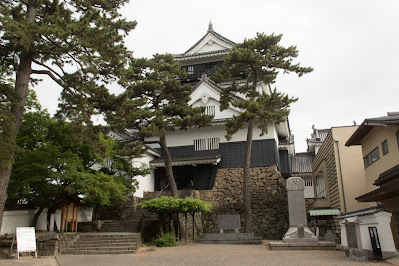
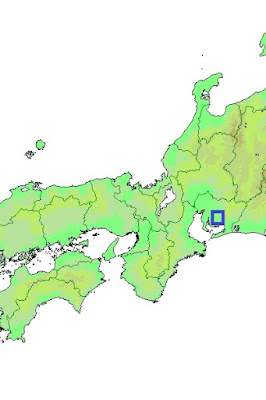











































































































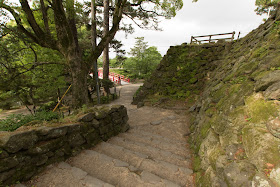








































































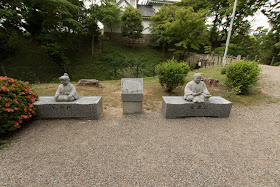







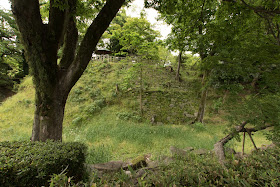
























No comments:
Post a Comment